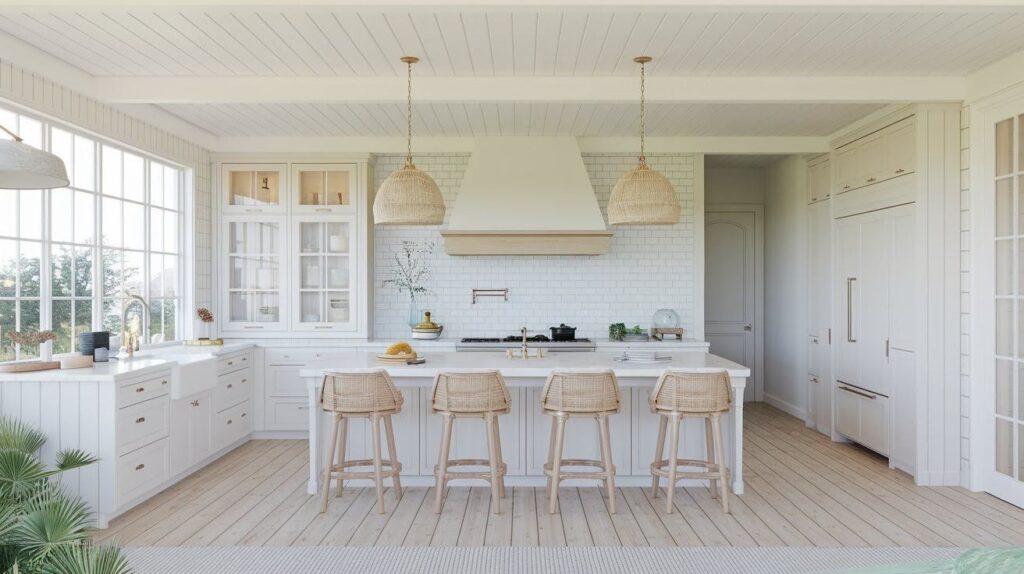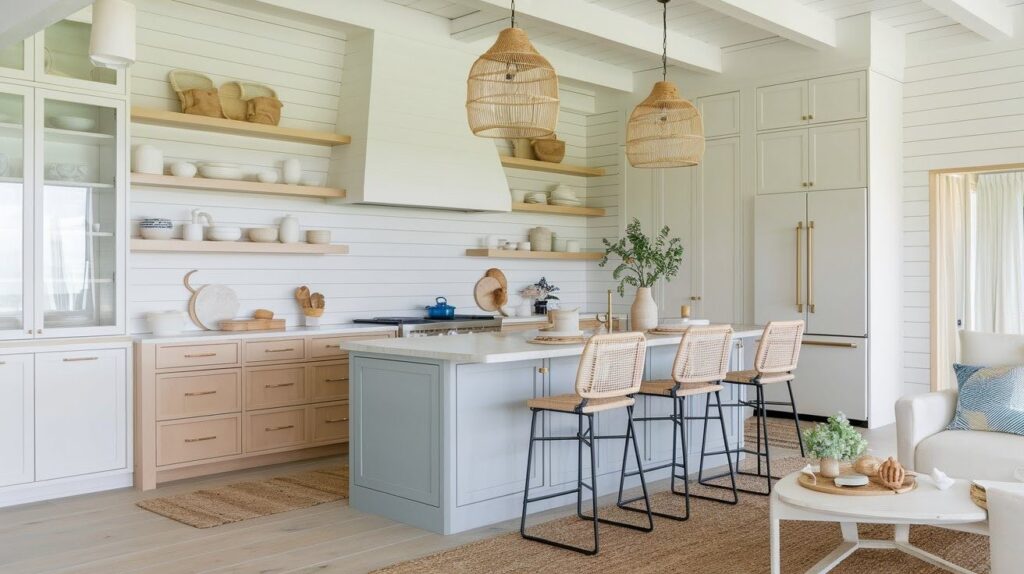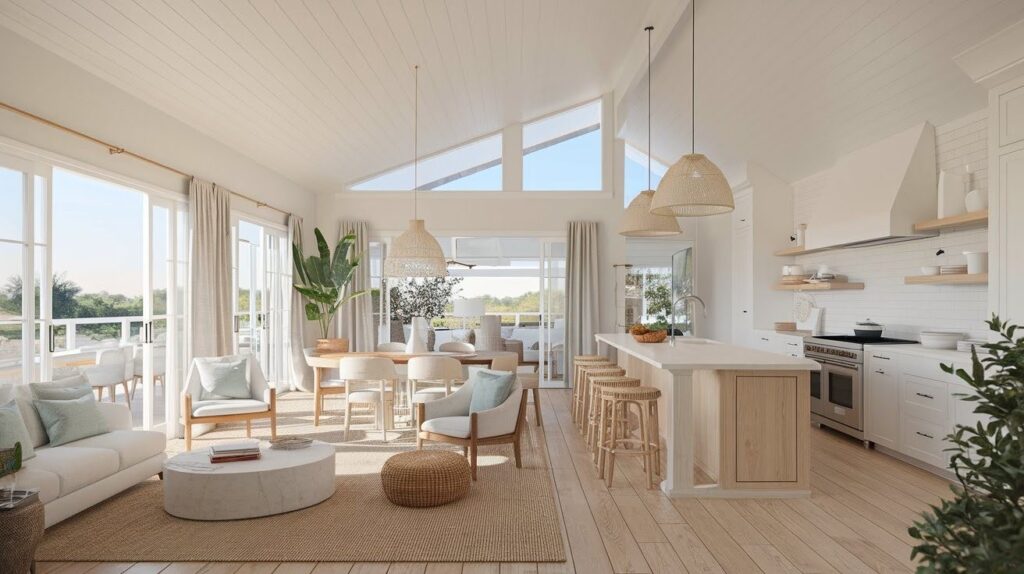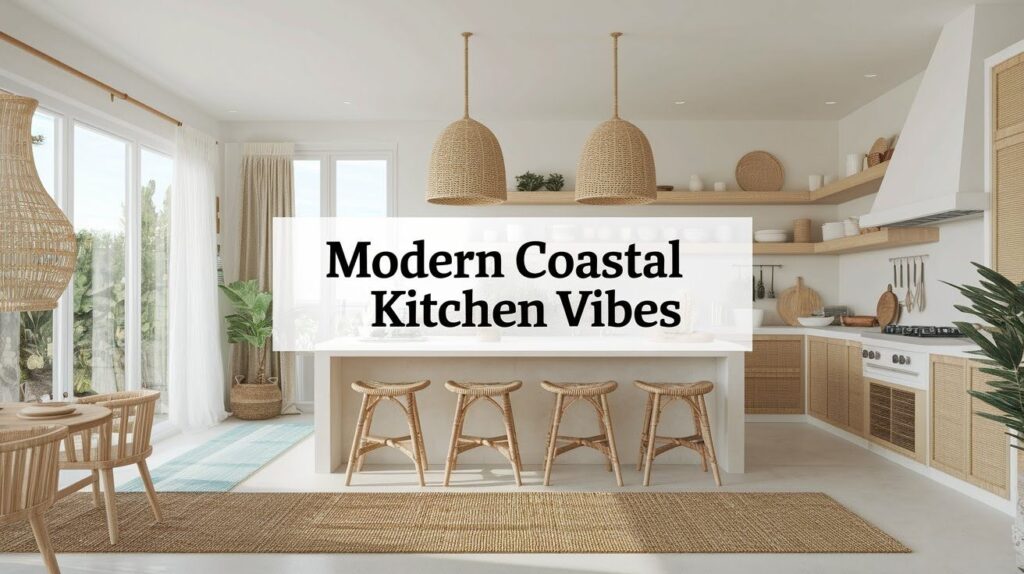The ocean never goes out of style. In 2025, coastal design continues to capture hearts with its fresh, calming vibe. This timeless look brings the serenity of seaside living into any home, no matter how far you live from the water.
Many homeowners struggle to create authentic coastal spaces. They end up with rooms that feel forced or overdone. This guide will show you exactly how to build a modern coastal home that feels natural and lived-in.
We’ve spent years studying what works in coastal design. By the end of this article, you’ll know how to choose the right colors, furniture, and accessories. You’ll understand which materials work best and how to avoid common mistakes. Most importantly, you’ll have a clear plan to create your own coastal retreat.
What Is a Modern Coastal Kitchen?

A modern coastal kitchen blends natural textures, soft ocean-inspired colors, and open, light-filled layouts to create a calm, airy space that feels effortlessly relaxed yet refined.
Defining the Style
A modern coastal kitchen captures the relaxed feel of beachside living. Think light-filled spaces that make you feel calm and happy. These kitchens blend comfort with sophistication without trying too hard.
The style draws inspiration from nature. You’ll see colors that remind you of sand, sea, and sky. Materials feel organic and real. Everything works together to create a space that breathes.
Key Characteristics
Color That Calms Modern coastal kitchens stick to neutral base colors. Whites, creams, and soft grays dominate the palette. Then come the ocean-inspired accents – gentle blues, seafoam greens, and sandy beiges. These colors never fight for attention.
Materials That Matter Natural materials are non-negotiable. Think weathered wood, natural stone, and woven textures. These elements add warmth and character. They age beautifully and feel authentic to touch.
Light and Space Openness defines the modern coastal kitchen. Large windows let in natural light. Islands replace walls when possible. Storage stays hidden to maintain clean lines. The goal is a space that feels spacious and connected to the outdoors.
Every element serves a purpose while maintaining that breezy, lived-in coastal charm.
Elements That Define a Modern Coastal Kitchen

Coastal kitchens layer soft, sea-inspired hues with natural textures like wood, stone, and rattan. Light-filled spaces, shaker cabinetry, woven lighting, and open shelving all contribute to a breezy, relaxed yet refined beachside aesthetic.
Hues of the Sea: Coastal Color Palettes
The right colors set the foundation for your coastal kitchen. Start with crisp whites as your base – they reflect light and create that airy feel. Add warm beiges and sandy tones to prevent the space from feeling cold.
Soft blues work as perfect accent colors. Think pale sky blue or weathered denim rather than bright navy. Muted grays add sophistication without overwhelming the space.
Two-tone cabinetry creates visual interest. Try white upper cabinets with light blue-gray lowers. Or pair cream cabinets with a soft blue island. This approach adds depth while keeping things cohesive.
Natural Materials & Textures
Coastal kitchens celebrate natural materials. White oak cabinets bring warmth and grain patterns that feel organic. Light wood islands create focal points while maintaining the casual vibe.
Stone countertops add durability and natural beauty. Rattan bar stools introduce texture and movement. Jute rugs ground the space with earthy appeal. Linen window treatments soften hard edges.
Woven pendant lights over islands combine function with coastal charm. These materials work together to create layers of texture that feel collected over time.
Coastal Kitchen Lighting Ideas
Lighting shapes the mood in coastal kitchens. Glass pendants over islands let light flow freely. Choose clear or seeded glass for that sea glass effect.
Brass fixtures add warmth without feeling heavy. Woven pendants bring in natural texture and cast interesting shadows.
Wall sconces flanking windows or artwork provide ambient lighting. Lantern-style fixtures work perfectly in breakfast nooks. Statement chandeliers over dining areas can feature rope details or weathered finishes.
Coastal-Inspired Cabinetry
Cabinet style makes or breaks your coastal look. Shaker doors provide clean lines without fuss. The simple frame-and-panel design feels timeless and appropriate.
Crisp white cabinets never go wrong in coastal spaces. They reflect light and feel fresh. Soft blue-gray tones add personality while staying true to the coastal palette.
Hand-painted finishes give cabinets character. Look for subtle brush marks or slightly uneven coverage. These imperfections feel authentic and lived-in.
Coastal Kitchen Backsplash Ideas
Your backsplash can make a major impact. Zellige tiles bring handmade charm with their irregular surfaces and subtle color variations. Each tile catches light differently.
Marble slabs create luxury while staying natural. Choose varieties with soft veining rather than dramatic patterns.
Ocean blue mosaics add color in small doses. Mix different shades of blue and white for depth.
Shiplap backsplashes bring farmhouse coastal vibes. Paint them white or soft gray for a modern twist on the classic look.
Countertops & Islands
Countertops need to handle daily use while looking beautiful. Marble brings natural patterns and cool touch. Quartz offers durability with consistent patterns.
Choose light colors that complement your cabinets. Avoid busy patterns that compete with other elements.
Oversized islands serve multiple purposes. They provide extra prep space, storage, and seating for casual meals. Size them appropriately for your space – they should feel generous without overwhelming the room.
Flooring & Ceiling Accents
Light-toned hardwood floors create the perfect foundation. Oak, maple, or pine in natural or whitewashed finishes work well. Wide planks feel more relaxed than narrow strips.
Weathered finishes add character without looking artificial. Hand-scraped textures bring depth and hide daily wear.
Wood beams on ceilings add architectural interest. Paint them white to keep things light, or leave natural for more contrast.
Shiplap ceilings create texture overhead. They work especially well in kitchens with higher ceilings where you want to add visual interest.
Open Shelving & Display
Open shelves break up solid cabinet runs and provide display space. Use them strategically – too many can look cluttered.
Wood shelves feel more coastal than metal or glass. Choose the same wood species as your island or other accents for consistency.
Style shelves with a mix of functional and decorative items. Stack white dishes, add a few cookbooks, include some coral or shells. Keep it simple and avoid overcrowding.
Group items in odd numbers and vary heights for visual interest. Leave some breathing room between objects. Remember – less is more in coastal design.
Furniture & Accessories That Complete the Look

Woven textures, natural fiber rugs, and subtle coastal accents bring warmth and authenticity to modern coastal kitchens. Stick to clean lines, neutral tones, and minimal beach-inspired decor to keep the look breezy, relaxed, and refined.
Woven & Natural Seating
The right seating brings your coastal kitchen to life. Rattan counter stools add instant warmth and texture. Their natural fibers catch light beautifully and age well over time.
Cane-back bar stools offer a more refined take on coastal seating. The woven backs provide visual interest while staying comfortable for daily use.
Look for pieces with clean lines and natural finishes. Avoid overly ornate details that compete with your kitchen’s calm vibe. The goal is furniture that feels collected rather than matched.
Consider mixing materials – pair a rattan stool with linen cushions, or choose wooden frames with woven seats. This layered approach feels more authentic than buying everything from one collection.
Textiles: Rugs, Drapes & Linens
Textiles soften hard kitchen surfaces and add crucial warmth. Natural fiber rugs work perfectly in coastal spaces. Jute rugs bring earthy texture and hide daily wear well.
Sisal rugs offer more durability in high-traffic areas. Their tight weave handles spills better while maintaining that natural look.
Choose rugs in neutral tones that complement your color palette. Avoid busy patterns that fight with other elements in the room.
Minimal Yet Beachy Decor
Coastal decor works best with a light touch. Resist the urge to fill every surface with beach-themed items. Too many anchors, seashells, or nautical signs make spaces feel like theme parks.
Instead, choose subtle coastal references. A piece of driftwood displayed simply. A bowl filled with smooth stones. A single piece of coral on an open shelf.
Abstract coastal artwork creates the right mood without being literal. Think paintings that capture the feeling of ocean waves or sandy beaches rather than obvious beach scenes.
Coastal Kitchen Layout Tips

Maximize Natural Light
Natural light converts any kitchen into a coastal retreat. Large windows become your best friend in creating that bright, airy feel that defines coastal living.
Consider installing oversized windows if your budget allows. They flood the space with sunshine and create strong connections to the outdoors. Position them to capture morning light in breakfast areas or evening light where you spend time cooking.
French doors leading to patios or decks extend your kitchen beyond its walls. They bring in maximum light while creating easy indoor-outdoor flow. Even when closed, they maintain visual connections to outdoor spaces.
Embrace Open Concept Design
Walls can kill the breezy feel coastal kitchens need. Open concept layouts create the spaciousness that makes coastal design work so well.
Removing walls between kitchen and dining areas makes both spaces feel larger. You gain better sight lines and improved traffic flow. Conversations happen more naturally when spaces connect.
The kitchen island often becomes the new room divider in open layouts. It provides separation without blocking views or light. Size your island to define spaces while maintaining easy movement around it.
Key Tips for Your Modern Coastal Kitchen
Color & Materials
- Start with white as your base color and add soft blues and sandy beiges as accents
- Choose two-tone cabinetry with white uppers and light blue-gray lowers for visual interest
- Select natural materials like white oak, stone, rattan, and linen for authentic texture
- Pick light-toned hardwood floors in wide planks for a relaxed foundation
Design Elements
- Install shaker-style cabinets in crisp white or soft blue-gray tones
- Add hand-painted finishes for character and lived-in charm
- Use Zellige tiles, marble slabs, or shiplap for backsplash options
- Choose oversized islands for both function and social gathering
Lighting & Windows
- Hang glass or woven pendant lights over islands for coastal charm
- Install large windows, French doors, or skylights to maximize natural light
- Use light-filtering treatments like sheer linen panels instead of heavy drapes
- Add wall sconces and lantern-style fixtures for ambient lighting
Conclusion
Creating your modern coastal kitchen comes down to mastering a few key elements. Focus on light colors, natural materials, and plenty of sunshine streaming through large windows. Choose furniture and fixtures that feel collected over time rather than perfectly matched.
The magic happens when you blend modern comfort with breezy coastal vibes. Your kitchen should work hard for daily life while maintaining that relaxed seaside feel. Mix practical storage with open shelving. Combine durable countertops with soft textile touches.
Remember, the best coastal kitchens feel personal and lived-in. Trust your instincts as you select colors, materials, and decor. With these foundations in place, you’ll create a space that brings the calm and beauty of coastal living into your everyday routine.
Frequently Asked Questions
What colors work best in a modern coastal kitchen?
Start with crisp white as your base and add soft blues, sandy beiges, and muted grays as accents. Two-tone cabinetry with white uppers and light blue-gray lowers creates visual depth while staying true to the coastal palette.
How do I avoid making my coastal kitchen look too themed?
Keep decor minimal and choose subtle coastal references rather than obvious beach items like anchors or seashells. Focus on natural materials, soft colors, and abstract artwork that captures the feeling of the coast without being literal.
What type of lighting works best for coastal kitchens?
Glass or woven pendant lights over islands provide both function and coastal charm, while natural light through large windows remains most important. Add wall sconces and lantern-style fixtures for ambient lighting that complements the breezy atmosphere.
Should I choose an open concept layout for my coastal kitchen?
Open concept layouts work perfectly for coastal design because they maximize airiness and natural light flow. Remove walls between kitchen and dining areas when possible, and use oversized islands to define spaces without blocking sight lines.
What materials give the most authentic coastal feel?
Natural materials like white oak cabinets, stone countertops, rattan seating, and linen textiles create the most authentic coastal atmosphere. Choose weathered finishes and hand-painted details that feel collected over time rather than perfectly new.

